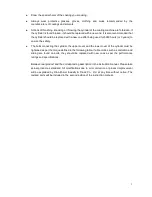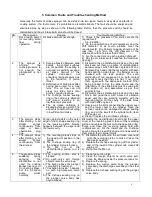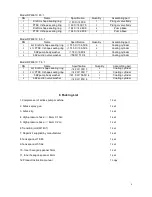
6
5 Common Faults and Trouble-shooting Method
Generally, the faults of airless sprayer can be divided into two types: faults in air system and faults in
coating system. If a fault occurs, it's prohibited to dismantle blindly. The fault should be analyzed and
eliminated step by step as shown in the following table. Before that, the pressure switch should be
dismantled and the air intake ball valve should be closed.
SN
Phenomenon
Reason
Trouble-shooting Method
1
Not enough power
for reversing, small
flow
during
operation.
Air intake amount not enough.
1) Check if the pressure of air source meets the
requirement?
(
0.6
~
0.8MPa
)
2) Do the specifications of air compressor and the
drift diameter of air source pipeline meet the
requirements? (the delivery capacity should not be
less than 1.2 m
3
/min, the drift diameter of the
pipeline should not be less than 20mm)
3) Are the connectors on each pipeline tightened?
4) Has the air intake switch reached the maximum
opening?
2
The
sprayer
is
whirring;
the
coating pressure is
not enough; the
atomization is not
good.
1) Severe abrasion between slide
boards; the contact surfaces
are not parallel; the sealing is
not good; air partially escapes;
air intake amount of the
cylinder
decreases;
not
enough spraying pressure due
to the reduction of piston
thrust.
2) Deformation of slide block after
having been used for a long
term. The air flow can not
press one slide block onto
another, causing leakage.
3) The O-shape rubber sealing
ring in the cylinder is abraded
and raised, resulting in an
insufficient air pressure.
4) The air intake cartridge is
blocked by foreign objects. The
air path is not smooth, resulting
in insufficient air intake
1) Dismantle the air-distributing block and the slide
block and put them on a piece of metallographic
abrasive paper, which has been spread out on a
flat plate. Push and grind them smoothly with both
hands and then clean them. The flatness can be
checked with red lead powder. The even
distribution of red squeegee oil on both contact
surfaces means that they are flat. If not, grind
them again with the above-said method. After
being grinded to flat, the slide board and the
intra-cavity of the slide block must be oiled with
20# engine oil, and assembled as per their
original forms.
2) Dismantle the air-distributing block and the slide
block, and grind them with a piece of abrasive
paper until they are working smoothly with the
reversing piston. Oil the cavity of the slide block
with clean 20# engine oil.
3) Unscrew all the bolts connecting the upper cover
and the lower cover to the cylinder. Open the
cylinder, replace the damaged O-shape sealing
ring, and oil the inwall of the cylinder with clean
20# engine oil.
4) Clean or replace the air intake cartridge.
3
The sprayer stops
after starting. A air
stream
sprays
continuously from
upper
or
lower
observation
plug
hole.
Foreign object exists on the outer
edge of the O-shape sealing ring
on the reversing piston; blowby
happens between the upper and
the lower cavity.
Dismantle the air-distributing board and the upper
cover of the reversing piston, take out the reversing
piston and replace the broken O-shape sealing ring.
Purge and clean the reversing piston hole with
compressed air. Oil the inwall and the O-shape
sealing ring with clean 20# engine oil and assemble
them as per their original forms
4
The sprayer stops
after starting. A air
stream
sprays
continuously from
the silencer.
1) The reversing block stops at
the dead point position in the
middle.
2) The O-shape sealing ring of
the cylinder piston is broken.
3) The
M8
nut
of
the
air-distributing piston rod is
lost.
1) Dismantle the screw on the air intake cover and
push the reversing piston to make it leave the
dead point position.
2) Replace the O-shape sealing ring of the cylinder,
and oil the inwall of the cylinder with clean 20#
engine oil.
3) Re-tighten the M8 nut.
5
The pressure drops
suddenly
during
spraying;
the
atomization is not
good; the coating
sprays like rays or
no coating sprays,
but the air-driven
pump
works
normally.
1) The coating suction inlet is
blocked.
2) On each valve port, foreign
objects raise the valve pug.
3) The spring above the plunger
valve body is fractured.
4)
“
Cavitation Erosion
”
happens
on each high-pressure valve
port.
5) The V-shape sealing ring on
the plunger valve body has
been abraded.
1) Clean the suction inlet.
2) Clean the foreign objects on each valve port.
Clean the strainer inside the pressure reservoir.
3) Replace the spring.
4) Replace the suction valve body, the plunger
valve body, the discharge valve body or the steel
ball.
5) Replace the V-shape sealing ring on the plunger
valve body.
Summary of Contents for DP6391
Page 2: ......
Page 11: ...9 9 Exploded Drawing...































